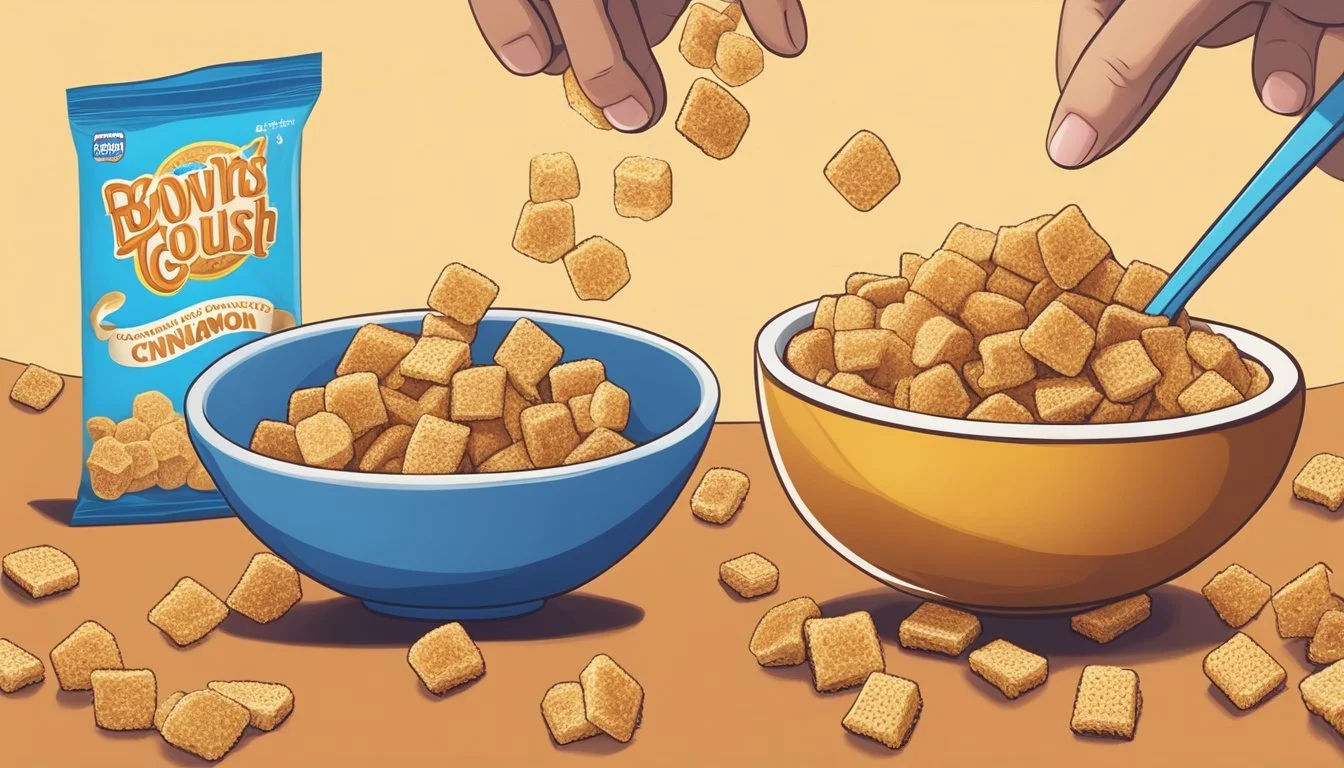Cinnamon Toast Crunch vs Honeycomb
Comparing Two Breakfast Favorites
This Article is Part of Our Breakfast Cereal Guide with Details on Cinnamon Toast Crunch Nutrition and Honeycomb Nutrition
When it comes to breakfast cereals, Cinnamon Toast Crunch and Honeycomb frequently spark debate among cereal enthusiasts. Both options offer a tasty start to the day, yet each comes with distinct nutritional profiles and flavor experiences. Cinnamon Toast Crunch boasts higher levels of iron, zinc, and several essential vitamins compared to Honeycomb, ensuring a fortified breakfast that supports overall health.
On the other hand, Honeycomb stands out with its lower calorie and fat content per serving, appealing to those who are mindful of their daily intake. Its simple, honey-flavored taste also provides a lighter option for those who enjoy a milder sweetness. These differences make each cereal appealing to different preferences and dietary needs.
For consumers comparing these cereals in 2024, the choice ultimately depends on personal priorities—whether one values the vitamin-enriched benefits of Cinnamon Toast Crunch or the lower calorie count and clean taste of Honeycomb. Both have their unique qualities that merit consideration.
History and Evolution
Cinnamon Toast Crunch and Honeycomb Cereal both have unique origins and have evolved significantly over time. This section highlights the key milestones and contributions of each cereal to the breakfast world.
Origins of Cinnamon Toast Crunch
Cinnamon Toast Crunch was introduced in 1984 by General Mills. The idea for the cereal came from a formula developed by John Mendesh, a scientist, and Elisabeth Trach, a product manager.
Initially, a competition inspired the creation, where children submitted cereal ideas. The company focused on capturing the taste of cinnamon toast in a crunchy form. Chef Wendell, a character from the commercials, became an iconic mascot and was featured heavily in advertising campaigns from 1987 to 2009.
The brand was initially aimed at children, but its appeal has widened over the years to include adults who grew up with the brand. It is known as one of the most popular cereals in the United States, maintaining high sales and market presence.
Development of Honeycomb Cereal
Honeycomb Cereal was introduced by Post Consumer Brands in 1965, almost two decades before Cinnamon Toast Crunch. Created to offer a unique honey-flavored cereal in a hexagonal shape, it quickly became a staple breakfast item.
Initially, Honeycomb's mascot was a cowboy named "The Honeycomb Kid," followed by a variety of other mascots over the years, including Crazy Craving and Bernard the Bee. Each mascot helped to position Honeycomb as a fun cereal option for kids.
Post aimed to differentiate Honeycomb with its distinct large pieces and honeycomb shape, and its formula has stayed relatively consistent. Despite some changes in marketing strategies and packaging, Honeycomb remains popular for its unique taste and texture.
Both cereals reflect the innovation and marketing prowess of their respective companies, General Mills and Post, and continue to be beloved breakfast choices today.
Nutritional Comparison
Cinnamon Toast Crunch and Honeycomb have distinct nutritional profiles. This section provides a comprehensive analysis to help readers make informed choices based on caloric content, sugar and carbohydrate breakdown, and protein, fat, and fiber content.
Caloric Content Analysis
Cinnamon Toast Crunch contains higher calorie content per serving compared to Honeycomb. A typical serving of Cinnamon Toast Crunch (1 cup) provides approximately 170 calories, while Honeycomb offers fewer, at around 120 calories per serving.
This difference is significant for those managing calorie intake. The higher calorie count in Cinnamon Toast Crunch can be attributed to its richer ingredient composition, including higher sugar and fat content.
Sugar and Carbohydrate Breakdown
Sugar content is a crucial factor for those concerned with dietary sugar intake. Cinnamon Toast Crunch contains about 12 grams of sugar per serving. Honeycomb, on the other hand, has a lower sugar content, close to 9 grams per serving.
For carbohydrates, both cereals are relatively high. Cinnamon Toast Crunch has around 33 grams of carbohydrates, while Honeycomb contains approximately 29 grams. This makes Cinnamon Toast Crunch slightly higher in sugars and carbs, impacting overall glycemic load and energy spikes.
Protein, Fat, and Fiber Content
Protein content in both cereals is modest. Cinnamon Toast Crunch provides around 2 grams of protein per serving, while Honeycomb matches this at about 2 grams as well. Neither cereal is particularly strong in delivering high protein.
Fat content varies more distinctly. Cinnamon Toast Crunch contains 4 grams of fat per serving, with insignificant saturated fat. Honeycomb is lower, with approximately 1.5 grams of fat per serving. This makes Honeycomb a leaner choice in terms of fat content.
Fiber is another essential nutrient. Cinnamon Toast Crunch offers 2 grams of fiber per serving, nearly twice that of Honeycomb, which provides around 1 gram. Fiber aids in digestion and can help in moderating the absorption of sugars and carbs, adding a slight edge to Cinnamon Toast Crunch for fiber-conscious consumers.
Ingredient Profiles
Cinnamon Toast Crunch and Honeycomb differ significantly in their ingredient makeup and additive profiles, influencing their taste, nutritional value, and dietary suitability.
Cereal Base and Flavoring Components
Cinnamon Toast Crunch primarily uses whole grain wheat and rice flour as its base. The cereal is well-known for its distinctive cinnamon and sugar coating, which gives it a unique flavor.
Honeycomb, in contrast, uses corn flour as its base and incorporates a honey flavor. This gives it a sweeter and simpler taste profile. Honeycomb’s ingredients include corn syrup, which acts as both a sweetener and a binding agent. Both cereals incorporate flavoring components that appeal to specific taste preferences.
Additives and Preservatives
Cinnamon Toast Crunch incorporates various additives. This includes maltodextrin, a starch-derived carbohydrate used to enhance texture and shelf life. BHT (butylated hydroxytoluene) is also present as a preservative to prolong freshness.
Honeycomb includes fewer additives but does contain soy lecithin, which is used as an emulsifier to maintain product consistency. Both cereals contain added vitamins and minerals, though the specific formulations vary. It's crucial to consider these additives and their potential effects when choosing a cereal.
Gluten-Free and Vegan Options
Cinnamon Toast Crunch is not gluten-free due to its whole grain wheat content. Additionally, it is not suitable for vegans as it often contains vitamin D3 derived from animal sources.
Honeycomb is similarly not gluten-free due to the inclusion of malt flavoring from barley. However, Honeycomb can be considered vegan-friendly as it does not contain animal-derived ingredients other than possible cross-contamination. Each cereal presents distinct challenges for those with dietary restrictions.
Matching their dietary preferences with the choice of cereal ensures that consumers make informed decisions about their breakfast options.
Health Considerations
Choosing between Cinnamon Toast Crunch and Honeycomb involves examining their health impact. Both cereals offer certain nutrients but also contain high sugar levels, which can have both benefits and risks.
Benefits of a Healthy Breakfast
A nutritious breakfast, such as one including fortified cereals, provides essential vitamins and minerals.
Cinnamon Toast Crunch and Honeycomb deliver significant amounts of Iron, Zinc, and B Vitamins. These nutrients are crucial for cognitive function and energy levels. Starting the day with cereals high in these vitamins helps meet daily nutritional requirements.
Including whole grains in the morning can also aid in sustained energy release. Although these cereals contain processed grains, their fortification makes them a viable option for a quick, nutrient-dense breakfast.
Risks of High Sugar Consumption
Both Cinnamon Toast Crunch and Honeycomb have high sugar contents, posing potential health risks.
Sugar consumption can lead to blood sugar spikes and subsequent sugar crashes, affecting concentration and causing fatigue. Managing energy levels becomes challenging with high-sugar diets.
Frequent high sugar intake is associated with weight gain, increased risk of Type 2 Diabetes, and heart disease. Parents buying cereals for children should be particularly cautious of these risks. Monitoring sugar intake from breakfast cereals is critical for maintaining long-term health.
Dietary Fibers and Whole Grains
Dietary fiber plays a significant role in digestive health, and is found in varying amounts in breakfast cereals.
Cinnamon Toast Crunch offers about 2g of fiber per serving, which is moderate. While it's not as fiber-rich as some other cereals like Shredded Wheat, it still provides beneficial fiber that helps with bowel regularity and controlling blood sugar levels.
Honeycomb contains lower fiber levels. Incorporating cereals high in whole grains and dietary fiber helps reduce the risk of chronic diseases such as heart disease and cancer. Choosing cereals with more whole grains and less refined content is generally healthier.
Carefully selecting cereals with higher fiber content can lead to improved digestive health and satiety.
Consumer Preferences
Consumer preferences for Cinnamon Toast Crunch and Honeycomb center around texture, taste experience, and brand loyalty. Each cereal offers a unique sensory experience and commands a distinct following within the breakfast cereal market.
Texture and Taste Experience
Cinnamon Toast Crunch is renowned for its crisp texture and strong cinnamon-sugar flavor. This cereal holds up well in milk, providing a crunchy yet sweet experience from the first to the last bite. Honeycomb, on the other hand, has a more airy and light texture, which some consumers find less dense but equally enjoyable.
Taste comparisons often spotlight Cinnamon Toast Crunch’s bold, sweet profile which appeals to fans of sweeter cereals like Cocoa Puffs and Lucky Charms. In contrast, Honeycomb offers a milder sweetness, drawing comparisons to cereals like Honey Nut Cheerios.
Ultimately, the choice between the two often depends on whether a consumer prefers a robust cinnamon flavor or a subtler honey taste.
Brand Loyalty and Market Presence
Cinnamon Toast Crunch, produced by General Mills, boasts a strong market presence thanks to widespread recognition and consistent branding efforts. The brand’s mascot and memorable advertising campaigns create a sense of nostalgia that resonates with long-time consumers.
Similarly, Honeycomb, a Post product, also enjoys a loyal following although it competes in a crowded field with classics like Cheerios. Post has adapted Honeycomb’s marketing strategies to appeal to newer generations, although it doesn't have the same level of iconic status as Cinnamon Toast Crunch.
Consumers' choices are often influenced by childhood memories and long-term brand relationships, ensuring that both cereals maintain their dedicated fan bases even as new products enter the market.
Serving Suggestions
Understanding how to best enjoy Cinnamon Toast Crunch and Honeycomb can enhance your breakfast experience. This includes knowing the recommended serving sizes and variations with different kinds of milk and milk alternatives.
Recommended Serving Sizes
When considering serving sizes, Cinnamon Toast Crunch and Honeycomb have distinct nutritional profiles.
Cereal Serving Size Calories Protein Fiber Cinnamon Toast Crunch 1 cup 170 2g 2g Honeycomb 1 cup 110 1g <1g
Cinnamon Toast Crunch contains more calories and slightly more protein and fiber per serving.
To maintain a balanced diet, it's essential to pair these cereals with additional protein sources such as eggs or yogurt.
Variations with Milk and Alternatives
Milk and milk alternatives can affect the taste and nutritional value of your cereal.
Dairy Milk: Pairs well with both cereals, providing additional calcium and protein.
Almond Milk: A lower-calorie option that complements Cinnamon Toast Crunch Cinnadust and Honeycomb's subtle sweetness.
Soy Milk: Offers a creamier texture with more protein, making it a fitting choice for these cereals.
Oat Milk: Enhances the flavor profile, especially with Cinnamon Toast Crunch Churros and Cinnamon Toast Crunch Creamy Cinnamon Spread.
Vegan readers may prefer plant-based alternatives with their cereal to maintain their dietary preferences.
Market Alternatives
Several alternatives to Cinnamon Toast Crunch and Honeycomb offer varying benefits, such as flavor, texture, and nutritional content. By exploring options like French Toast Crunch and Keto-friendly cereals, readers can find the best fit for their dietary needs and taste preferences.
Comparison with Other Brands
French Toast Crunch is highly similar to Cinnamon Toast Crunch in its sweet, cinnamon flavor but offers a distinct French toast twist.
Golden Grahams appeals to those who enjoy honey-flavored cereals but want a different crunch compared to Honeycomb.
Froot Loops and Rice Krispies cater to different taste buds, offering fruity and simple rice flavors respectively while targeting similar textures.
Raisin Bran and Life provide more fiber and can be suitable for those seeking healthier options.
Frosted Flakes competes with Cinnamon Toast Crunch by delivering a sugary taste but does not match the cinnamon flavor profile.
Low-Sugar and Low-Carb Options
For health-conscious consumers, low-sugar and low-carb cereals can be critical.
Barbara's Original Puffins contains just 5g of sugar per serving, offering a healthier alternative to high-sugar cereals like Cap'n Crunch.
Keto-friendly options, such as HighKey's line of cereals, serve individuals on low-carb diets, often providing more protein and fewer carbs.
Shredded Wheat stands out by containing no added sugar, making it one of the most straightforward healthy alternatives on the market.
These alternatives cater to specific dietary needs without compromising on taste. The selection of low-sugar and low-carb options ensures diverse preferences can be satisfied, from Keto to general low-sugar diets.
Environmental and Ethical Considerations
When comparing Cinnamon Toast Crunch and Honeycomb cereals, it is essential to examine their environmental impact and ethical sourcing practices. Ensuring that agricultural processes are sustainable and workers are treated fairly is crucial for the long-term health of our planet and society.
Sustainable Production Practices
Cereal production, particularly for products like Cinnamon Toast Crunch, relies heavily on agricultural practices that impact the environment. Sustainable methods include the reduction of pesticide use, the implementation of crop rotation, and the use of organic fertilizers. General Mills, which manufactures Cinnamon Toast Crunch, has taken steps to enhance sustainability by aiming to source ingredients responsibly and improve water and energy efficiency in farming.
Honeycomb's production can benefit from similar sustainable practices. Both brands need to consider the carbon footprint of their supply chains. Efforts towards sustainability help preserve biodiversity, ensure soil health, and protect surrounding ecosystems. Consumers increasingly value eco-friendly products, making sustainability not just an ethical choice, but also a strategic market decision.
Ethical Sourcing of Ingredients
Ethical sourcing is essential to ensure fair labor practices and community support. General Mills has committed to better wages and working conditions for their labor force and source regions. They strive for transparency in their supply chain, ensuring that raw materials, like sugar and corn, are produced under ethical conditions.
For both Cinnamon Toast Crunch and Honeycomb, ethical sourcing also involves supporting smallholder farms, respecting land rights, and avoiding exploitative practices. By focusing on ethical sourcing, these brands can contribute to the well-being of farming communities and enhance the quality of life for those involved in their production. Ethical practices can reinforce brand loyalty and trust among consumers who are mindful of social responsibility.
More on Cinnamon Toast Crunch
Cinnamon Toast Crunch vs French Toast Crunch: Which is better?
Cinnamon Toast Crunch vs Honey Nut Cheerios: Which is better?
Cinnamon Toast Crunch vs Kellogg's Apple Jacks: Which is better?
Cinnamon Toast Crunch vs Kellogg's Froot Loops: Which is better?
Cinnamon Toast Crunch vs Post GrapevsNut Flakes: Which is better?
Cinnamon Toast Crunch vs Post Raisin Bran Cereal: Which is better?









